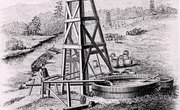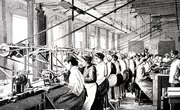Wedgewood stoves were made in the 1930s, 1940s and 1950s. James Graham opened the first Wedgewood factory in 1919, and the company survived for several decades, becoming renowned for their products' quality and durability. They are still sold today as vintage stoves and used by antique lovers and experienced cooks.
Early History
Wedgewood stoves were first manufactured In 1919, when James Graham opened the first Wedgewood factory in Newark, California (which is in Alameda County) on land donated by Senator James Fair. Born in Ontario, Canada, Graham moved to the California in 1882 and worked to make his company viable in a region with relatively little transportation compared to the East Coast. His factory was at the terminal of a narrow gauge railroad--which he reportedly worked on himself to keep pertinent exports and imports moving--which made the success of Wedgewood stoves possible. In the early days, Wedgewood stoves burned wood or coal.
Significance
Wedgewood stoves proved significant in the history of stove-making in the United States, as Graham's company was the first to manufacture the appliances on the West Coast. Before Wedgewood stoves, these now-essential cooking tools were imported from the East Coast in parts and then assembled. Wedgewood made purchasing stoves more affordable--and therefore more realistic--for more people in the Pacific region.
Key Features
Wedgewood stoves were known for their durability, performance and certain key features. They ranged from a mere 36 inches wide to 60 inches and came in a variety of vibrant colors. Many models had dual ovens, built-in warming drawers and a cooktop griddle. After gas burners were introduced, most Wedgewood stoves were built with this technology, a major advance for cooks accustomed to shoveling coal or wood into their stoves and continually monitoring heat levels.
After Graham's Death
James Graham died in 1898 at the age of 55. The company continued to grow and by 1931, it employed 350 people. Though Wedgewood stoves' manufacturing facility remained in Newark, the appliances were displayed in San Francisco, Los Angeles and Seattle in sales rooms. Wedgewoods remained exclusively wholesale, and by the 1930s, 95 percent of the stoves manufactured were gas burning.
The 21st Century
In the 21st century, Wedgewood stoves are still sold as working appliances and can be found through antique dealers, vintage and specialty kitchen suppliers, restoration specialists and--of course--private sellers. Working stoves usually cost around $1,000. Repairs and part replacements can also be made through these sources.
Related Articles
Writer Bio
Elizabeth Jennings began publishing creative works in 1988 and has been a professional editor and writer since 2002. She holds a dual Bachelor of Arts in anthropology and philosophy.










